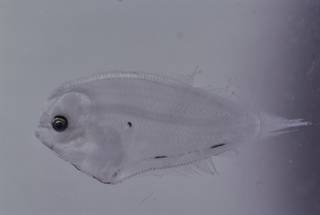
| Intro | | Search taxa | | Browse taxa | | Distributions | | Terminology | | References | | Statistics | | Online sources | | Tutorial | | Log in |
WoRMS taxon detailsBothidae Smitt, 1892
marine, brackish,
Not documented
Description Distribution: tropical and temperate Atlantic, Indian, and Pacific oceans. Both eyes on left side in most species....
Description Distribution: tropical and temperate Atlantic, Indian, and Pacific oceans. Both eyes on left side in most species. Preopercle margin free and distinct. No spines in fins. Dorsal fin origin above or anterior to upper eye. Dorsal and anal fins separate from caudal fin. Branchiostegal membranes united. Anus on blind side. Egg yolk with a single oil globule. Lefteye flounders are found in all tropical and temperate seas, and several species are of commercial importance. [details]
Froese, R. and D. Pauly. Editors. (2025). FishBase. Bothidae Smitt, 1892. Accessed through: World Register of Marine Species at: https://marinespecies.org/aphia.php?p=taxdetails&id=125576 on 2025-07-16
Date action by
Nomenclaturebasis of record
van der Land, J.; Costello, M.J.; Zavodnik, D.; Santos, R.S.; Porteiro, F.M.; Bailly, N.; Eschmeyer, W.N.; Froese, R. (2001). Pisces, <B><I>in</I></B>: Costello, M.J. <i>et al.</i> (Ed.) (2001). <i>European register of marine species: a check-list of the marine species in Europe and a bibliography of guides to their identification. Collection Patrimoines Naturels,</i> 50: pp. 357-374 (look up in IMIS) [details] Taxonomytaxonomy source
Van Der Laan, R.; Eschmeyer, W. N.; Fricke, R. (2014). Family-group names of Recent fishes. <em>Zootaxa.</em> 3882(1): 1-230., available online at https://doi.org/10.11646/zootaxa.3882.1.1 [details] Available for editors Othercontext source (PeRMS)
Chirichigno, N.; Cornejo, M. (2001). Catálogo comentado de los peces marinos del Perú. <em>2ª ed. Instituto del Mar de Perú. Publicación Especial. Callao.</em> 314 p. [details]
additional source Fricke, R., Eschmeyer, W. N. & Van der Laan, R. (eds). (2025). ECoF. Eschmeyer's Catalog of Fishes: Genera, Species, References. <em>California Academy of Sciences. San Francisco.</em> Electronic version accessed dd mmm 2025., available online at http://researcharchive.calacademy.org/research/Ichthyology/catalog/fishcatmain.asp [details]  Present Present  Inaccurate Inaccurate  Introduced: alien Introduced: alien  Containing type locality Containing type locality
Unreviewed
Description Distribution: tropical and temperate Atlantic, Indian, and Pacific oceans. Both eyes on left side in most species. Preopercle margin free and distinct. No spines in fins. Dorsal fin origin above or anterior to upper eye. Dorsal and anal fins separate from caudal fin. Branchiostegal membranes united. Anus on blind side. Egg yolk with a single oil globule. Lefteye flounders are found in all tropical and temperate seas, and several species are of commercial importance. [details]
|


